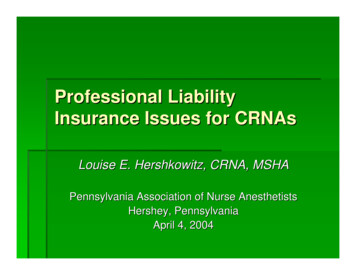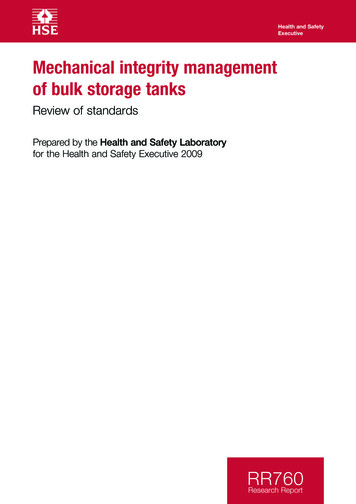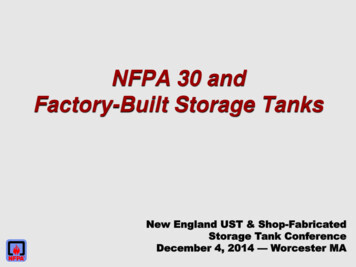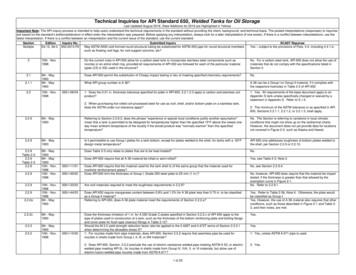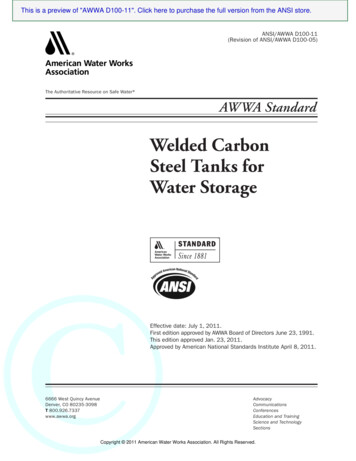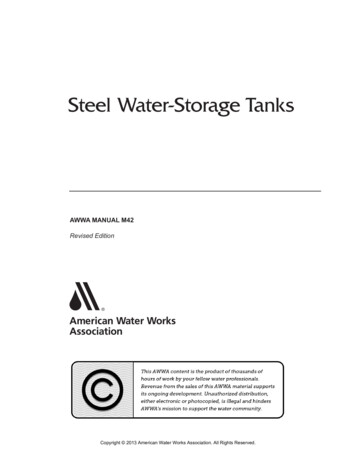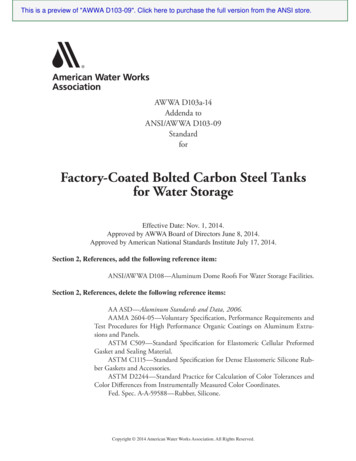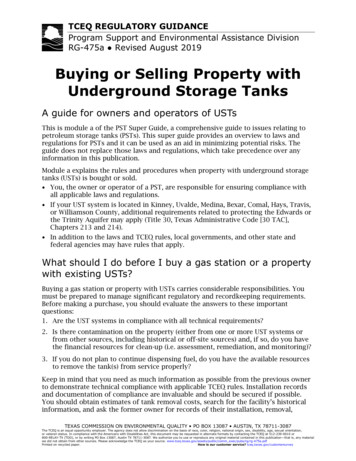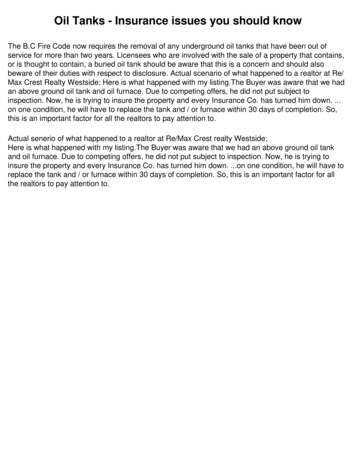
Transcription
Oil Tanks - Insurance issues you should knowThe B.C Fire Code now requires the removal of any underground oil tanks that have been out ofservice for more than two years. Licensees who are involved with the sale of a property that contains,or is thought to contain, a buried oil tank should be aware that this is a concern and should alsobeware of their duties with respect to disclosure. Actual scenario of what happened to a realtor at Re/Max Crest Realty Westside; Here is what happened with my listing.The Buyer was aware that we hadan above ground oil tank and oil furnace. Due to competing offers, he did not put subject toinspection. Now, he is trying to insure the property and every Insurance Co. has turned him down. .on one condition, he will have to replace the tank and / or furnace within 30 days of completion. So,this is an important factor for all the realtors to pay attention to.Actual senerio of what happened to a realtor at Re/Max Crest realty Westside;Here is what happened with my listing.The Buyer was aware that we had an above ground oil tankand oil furnace. Due to competing offers, he did not put subject to inspection. Now, he is trying toinsure the property and every Insurance Co. has turned him down. .on one condition, he will have toreplace the tank and / or furnace within 30 days of completion. So, this is an important factor for allthe realtors to pay attention to.
Understanding Oil TanksInsurance Issues you should knowCREAThe Canadian Real Estate Associationinfo@crea.ca
UNDERSTANDING OIL TANKSReal estate transactions can be put at risk if a client purchases a property with an underground fueloil tank and is denied homeowners insurance. If a client finds that an existing tank has not beenregistered, remedial action may cost them thousands of dollars.Homebuyers have expressed concern over home insurance policies being denied or being unableto obtain home insurance as a result of underground storage tanks. A number of transactions havefallen through on closing as a result.According to the Insurance Bureau of Canada, a home with an exterior oil tank older than 15years, or an interior tank older than 25 years will not be insured.The problemThe problem is that many oil tanks are corroding from the inside out, so the failure is not readilyvisible. This often occurs from condensation that builds up inside the tank. Since oil is lighter thanwater, the water goes to the bottom of the tank and causes corrosion. The first sign of a bad tank couldbe an odour of oil in the air. There might be rust or corrosion where the legs are welded to the tank.Other symptoms could include a leak in the fuel filter or the nozzle becoming plugged.Insurance companies are concerned that an old oil tank can leak and spill hundreds of litres of heating oil into the home, or into the ground. Spilled oil can quickly contaminate soil and groundwater. If theleak finds its way into a sump pump or floor drain, the spill will undoubtedly make it a very expensiveclean up. With outside storage tanks, where rust and corrosion are more common, a spill cancontaminate the soil or make its way into the nearby streams or rivers.What may seem like a simple clean-up can in fact be a complicated task to replace the leaking tankand supply lines, remove contaminated soil, replace the foundation and treat groundwater.The cost to repair a leaking oil tank can range from several hundred to several thousand dollars.The most commonly used tanks for heating oil are steel containers that hold about 1,000 litres andweigh close to 1,000 kg when full. Their odd shape, which lets them easily pass through doorways,also makes them unstable unless they are properly secured from tipping over.When buying a tank, look for a label that tells the date and location the tank was made. The labelshould clearly indicate that it meets a national construction standard.The National Fire Code recommends that all piping and connections on oil tanks be made of metal, notplastic or rubber.Buying a used oil tank is not recommended. Rust and sludge that has collected in the tank will causeburner problems.
Indoor tanksMany home oil tanks are designed and built for indoor use. Indooroil tanks will generally last longer and improve the efficiency ofoil-fired appliances. Indoor storage tanks are less likely to spill anddo not emit an odor.When installing an indoor oil tank, place the tank where it can beeasily inspected but will not be damaged by normal householdactivities.If possible, surround the tank with a low curb and dyke to containany leaked oil. Never place a tank against a wall, as this cancause the tank to rust.Cover the supply line and filter to protect them from damage.Storing objects on top of the tank could potentially lead to damage.Outdoor tanksOutdoor tanks should be placed at least 15 m from any well. Toprevent rust, cover the tank's exterior with enamel paint.Support the tank properly to prevent it from shifting or fallingover. Prepare a non-flammable base using concrete or patiostones. Wood is not recommended as it can burn, rot andretains water, which causes the tank to rust. Slope the tankslightly toward the drain.Ensure the tank stays upright and does not make contact witha wall.To allow for changes in ground level, the oil burner supply lineshould have a horizontal loop before entering the building. Theline should be sloped toward the building to prevent water collection.If possible, the oil filter should be placed inside the home because collected water can freeze andcause splitting.The supply line can be installed through the top of the tank to protect againstbreaking the line and draining the tank.If frost heaving or ground settling causes an tank to move, have it leveled properly.
Underground oil tanksMany underground oil tanks have reached the end of their useful lives and are beginning to corrode,rust and leak. Increasing homeowner insurance claims resulting from leaking oil tanks are veryexpensive and can lead to high insurance rates, or even refusal of coverage.It is a homeowner’s legal responsibility to properly maintain the oil tank and clean up any spills or leaksthat may occur.Leaking underground storage tanks may create several hazards including: Products and product vapours can generate apotentially explosive mixture; Products can enter surface water; Products can enter drinking water; Products can contaminate surrounding soil; Products can damage property.Problems with underground oil tanks may complicate the process of applying for homeowner'sinsurance and, in extreme cases, may adversely affect real estate transactions themselves.What’s required in OntarioIn Ontario, effective May 1, 2002, fuel distributors may not supply fuel oil to an undergroundtank that is not registered with the Technical Standards and Safety Authority (TSSA).To ensure uninterrupted oil supply, tank owners must complete the TSSA's Underground FuelOil Application Form and may be required to upgrade their tank with specific leak and spillprevention equipment depending on the age of the tank.Upon approving an application form, the TSSA will assign a registration number to the tank.The tank owner must provide the registration number to a fuel distributor to ensureuninterrupted fuel supply.To receive a copy of the Underground Fuel Oil Application Form, or for more information, callthe Technical Standards and Safety Authority toll-free at 1-877-682-8772.How to check if an underground oil tank is leakingBecause they are buried, it is difficult to detect a leaking tank. Some underground tanks may leak foryears without owners realizing it. If oil consumption suddenly goes up the tank may have sprung alarge leak.There are companies that test underground tanks for leaks. Call the fuel supplier to help findunderground tank testing companies.What to do if an oil tank is leakingSuspect a leak in an underground oil tank? Call a TSSA registered fuel oil contractor to help find andstop the leak and clean up any leaked fuel oil. In Ontario, homeowners are also required to call theSpills Action Centre of the Ministry of Environment at 1-800-268-6060. Insurance companies may alsohave resources of information.Underground tanks are required to be upgraded with specific leak and spill prevention equipment orbe removed.What to do with unused underground oil tanksAn unused underground oil tank must be removed and all contaminated soil must be cleaned.Underground tanks are required to be removed by TSSA registered fuel oil contractors.When an underground tank is removed, the soil around the tank must be assessed for contaminationand all contamination cleaned.
Tank maintenanceSpills can be avoided by detecting problems early on. If asked, most fuel companies will inspect thetank yearly, and will report any problems or recommend repairs.At least once a year, change the filter and remove any sludge and water from the tank. Check with afuel company about oil additives to reduce the water in the tank.Occasionally, check the outside of the tank for any rust. Clean off any spots and apply a rustproof paint.When replacing an oil tank, be careful not to transfer all of the contents of the old tank into the newone. Accumulated water, sludge and bacteria will cause the new tank to corrode and leak.Keep the tank relatively full over the summer so that less water from condensation will collect inside.Oil tanks should be checked for problems after each fuel delivery.What comsumers should do when buying or selling ahome with an oil tankPrior to closing, contact the fuel oil supplier for the home and determine if the basic or comprehensiveinspections of the tank and oil-heating appliance have been completed. The fuel oil supplier will haveinformation about the servicing and inspection program that is in place for the home.Selling a home with an oil tank? REALTORS should expect questions regarding the age of the tank,location and proof that the tank installation meets safety requirements. Purchasers should expect to beasked, by their insurer, to provide this type of information when applying for insurance.
Provincial standardsAlthough most provinces currently have safety standards for oil tanks, provincial environment departments across Canada are now reviewing installation standards for home oil tanks. Below are the oiltank regulations and requirements for Alberta, Ontario, Newfoundland, PEI and Saskatchewan. Forinformation about oil tanks in other provinces, see the resource section.AlbertaIn Alberta, underground and aboveground tanksmust be registered with the Petroleum TankManagement Association of Alberta (PTMAA).Aboveground storage tanks of capacity smaller than2,500 litres do not have to be registered. Eachcompartment of multi-compartment tanks is considered an individual storage tank. Registration feesare 50.00 per tank per year.OntarioAccording to the Technical Standards and SafetyAuthority of Ontario (TSSA), if the underground fueltank was installed: British ColumbiaThe B.C Fire Code now requires the removal of anyunderground oil tanks that have been out of servicefor more than two years. Licensees who areinvolved with the sale of a property that contains, oris thought to contain, a buried oil tank should beaware that this is a concern and should also beaware of their duties with respect to disclosure.NewfoundlandThe Government of Newfoundland and Labradorreport that approximately 66,000 households use oilas their main source of heat. During the 2000/2001heating season, there were approximately 600 residential oil spills reported. The Insurance Bureau ofCanada reports that between 1996 and 1998, thetotal dollars paid out in claims from domestic oil tankleaks and spills in Atlantic Canada exceeded 11.9million.Prince Edward IslandIn early 2002, Prince Edward Island implementedregulations regarding domestic oil tank installations.When fully implemented, the PEI regulations willensure that a licensed installer installs oil tanks anda licensed installer, or inspector, inspects existingsystems. All tanks will be replaced every 15 - 25years depending on the tank design and thickness.SaskatchewanIn Saskatchewan, oil tanks are regulated by theHazardous Substances and Waste DangerousGoods Regulations. Underground oil tanks in sitesof moderate environmental sensitivity (considered"Class B") must meet the standards outlined in theRequirements for Underground Petroleum StorageTank Systems at "Class B" Locations. Thisdocument is available on the SaskatechwanEnvironment tion/hazardous/CLASSB.htm 25 or more years ago - the tank must beremoved or upgraded by October 1, 200620 to 24 years ago - the tank must beremoved or upgraded by October 1, 200710 to 19 years ago - the tank must beremoved or upgraded by October 1, 2008Less than a year to 9 years ago - the tank mustbe upgraded or removed by October 1, 2009.Underground tanks with a storage capacity greaterthan 5,000 litres will need to be tested for leaksannually. Unused underground tanks are requiredto be removed and any contamination cleaned.TSSA investigation statistics show that old, rustingunderground tanks and poorly maintained anddefective heating systems are the leading sourcesof oil leaks and spills. These leaks and spills canresult in serious environmental damage and costlyclean-up repairs for homeowners.A leaking oil tank in the basement can become aserious fire and environmental hazard. Inside oroutside the house, it can contaminate groundwater,affecting wells or other drinking water supplies nearby.The first step for owners is to register their tank, freeof charge, with the TSSA. New regulations requireall underground tanks to be registered with theTSSA by May 1, 2002 or oil will not be delivered tothe tank. Oil tanks can be registered by completingthe Underground Fuel Oil Application Form andreturning it to TSSA. A registration number will beassigned to each tank that must then be given to afuel distributor to ensure uninterrupted fuel supply.It is important for underground oil tank owners totake safety into consideration. Old, undergroundtanks are very likely to leak, and oil leaks willcontaminate soil and groundwater and result inexpensive environmental clean-up costs.
ResourcesFor additional information on oil tank safety, contact the following organizations:AlbertaOntarioPetroleum Tank Management Association ofAlberta (PTMAA)Suite 980, 10303 Jasper AvenueEdmonton, Alberta T5J 3N6(780) 425-8265 or 1-866-222-8265http://www.ptmaa.ab.caTechnical Standards and Safety Authority (TSSA)4th Floor, West Tower3300 Bloor Street WestToronto, Ontario M8X 2X4(416) 325-2000Toll-Free (outside Toronto) 1-877-682-8772 (TSSA)E-mail: contactus@tssa.orghttp://www.tssa.orgBritish ColumbiaOffice of the Fire CommissionerMinistry of Community Aboriginal and Women'sServicesP.O. Box 9491 Stn Prov GovtVictoria, BC V8W 9N7(250) .ca/firecom/ManitobaMechanical and Engineering BranchManitoba Labour and Immigration500 - 401 York AvenueWinnipeg, MB R3C 0P8(204) 945-1359New BrunswickP.E.IDepartment of Fisheries, Aquaculture andEnvironmentJones Building11 Kent StreetP.O. Box 2000Charlottetown, PE C1A 7N8Telephone: (902) 368-5000http://www.gov.pe.caQuébecMinistry of the EnvironmentÉdifice Marie-Guyart, 6th floor675 René-Lévesque Boul. EastQuébec (Québec) G1R 5V7(418) 521-3830 or 1-800-561-1616New Brunswick Department of the Environment565 Priestman St.P.O. Box 6000Fredericton, NB E3B 5H1(506) 444-5149To report an oil tank leak or spill: 1-800-565-1633NewfoundlandCanadian Oil Heat AssociationNewfoundland tchewanSaskatchewan Ministry of the Environment3211 Albert StreetRegina, SK S4S 5W6(306) 787-2700http://www.se.gov.sk.ca/Environmental Resource Network inquiry line1-800-567-4224 (in province only). Ask for theHazardous Substances and Waste DangerousGoods Regulations.YukonNova ScotiaNova Scotia Department of the EnvironmentPO Box 21075151 Terminal Road, 5th FloorHalifax, NS B3J 3B7(902) 424-5300Yukon Housing Corporation410H Jarvis StreetWhitehorse, Yukon(867) 667-5759Toll Free: 1-800-661-0408
Any questions or comments about the servicesor products CREA provides?You can contact us on-line at:info@crea.caCREAThe Canadian Real Estate Association344 Slater Street, Suite 1600, Ottawa, Ontario, K1R 7Y3Tel: (613) 237-7111 FAX: (613) 234-2567
Oil Tanks - Insurance issues you should know The B.C Fire Code now requires the removal of any underground oil tanks that have been out of service for more than two years. Licensees who are involved with the sale of a property that contains, . inspections of the tank and oil-heating appliance


